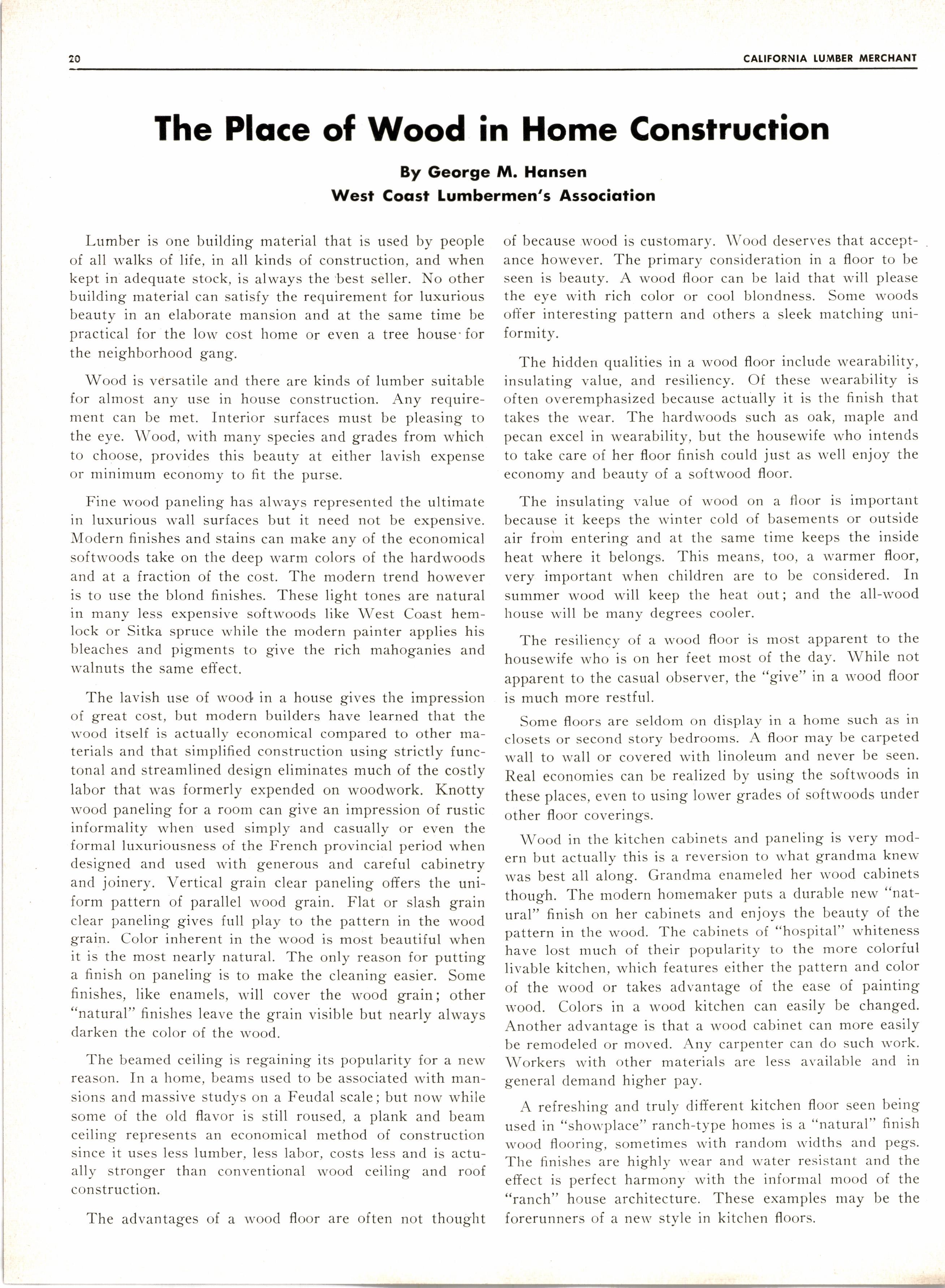
3 minute read
The Plqce of Wood in Home Construction
By George M. Hqnsen West Coqst Lumbermen's Associqfion
Lumber is one building material that is used by people of all vi'alks of life, in all kinds of construction, and when kept in adequate stock, is always the 'best seller. No other building material can satisfy the requirement for luxurious beauty in an elaborate mansion and at the same time be practical for the lo,rv cost home or even a tree house'for the neighborhood gang.
Wood is versatile and there are kinds of lumber suitable for almost any use in house construction. Ary requirement can be met. Interior surfaces must be pleasing to the eye. Wood, with many species and grades from lvhich to choose, provides this beauty at either lavish expellse or minimum economy to fit the purse.
Fine wood paneling has al.rvays represented the ultimate in luxurious rvall surfaces but it need not be expensive. Modern finishes and stains can make any of the economical softwoods take on the deep warm colors of the hardwoods and at a fraction of the cost. The modern trend however is to use the blond finishes. These light tones are natural in many iess expensive softwoods like West Coast hemlock or Sitka spruce wllile the modern painter applies his bleaches and pigments to give the rich mahoganies and rvalnuts the same effect.
The lavish use of wood in a house gives the impression of great cost, but modern builders have learned that the n'ood itself is actually economical compared to other materials and that simplified construction using strictly functonal and streamlined design eliminates much of the costly labor that was formerly expended on woodwork. Knotty rvood paneling for a room can give an impression of rustic informality wl.ren used simply and casually or even the formal luxuriousness of the French provincial period when designed and used rvith generous and careful cabinetry and joinery. Vertical grain clear paneling offers the uniform pattern of parallel rvood grain. Flat or slash grain clear paneling gives full play to the pattern in the wood grain. Color inherent in the wood is most beautiful when it is the most nearly natural. The only reason for putting a finish on paneling is to make the cleaning easier. Some finishes, like enamels, will cover the wood grain; other "natural" finishes leave the grain visible but nearly always darken the color of the wood.
The beamed ceiling is regaining its popularity for a new reason. In a home, beams used to be associated .ivith mansions and massive studys on a Feudal scale; but norv while some of the old flavor is still roused, a plank and beam ceiling represents an economical method of construction since it uses less lumber. less labor. costs less and is actually stronger than conventional 'ivood ceiling and roof construction.
The advantages of a r,vood floor are often not thought of because wood is customary. Wood deserves that acceptance however. The primary consideration in a floor to be seen is beauty. A wood floor can be laid that will please the eye with rich color or cool blondness. Some woods offer interesting pattern and others a sleek matching uniformity.
The hidden qualities in a wood floor include wearabilitl', insulating va1ue, and resiliency. Of these rvearability is often overemphasized because actually it is tl-re finish that takes the 'rvear. The hardwoods such as oak, maple and pecan excel in wearability, but the housewife who intends to take care of her floor finish could just as 'ivell enjoy the economy and beauty of a softwood floor.
The insulating value of wood on a floor is important because it keeps the rvinter cold of basements or outside air froin entering and at the same time keeps the inside heat where it belongs. This means, too, a r.varmer floor, very important when children are to be considered. In summer wood will keep the heat out; and the all-rvood house will be many degrees cooler.
The resiliency of a wood floor is most aPparent to the housewife who is on her feet most of the day. While not apparent to the casual observer, the "give" in a u'ood floor is much more restful.
Some floors are seldom on display in a home such as in closets or second story bedrooms. A floor may be carpeted r,vall to rvall or covered with linoleum and never be seen. Real economies can be realized by using the softr'voods in these places, even to using lorver grades of softrvoods under other floor coverings.
Wood in the kitchen cabinets and paneling is very modern but actually this is a reversion to u'hat grandma knerv r'vas best all along. Grandma enameled her r'vood cabinets though. The modern homemaker puts a durable nerv "natural" finish on her cabinets and enjoys the beauty of the pattern in the wood. The cabinets of "hospital" whiteness have lost much of their popularity to the more colorful livable kitchen, which features either the pattern and color of the wood or takes advantage of the ease of painting \vood. Colors in a wood kitchen can easily be changed. Another advantage is that a wood cabinet can more easily be remodeled or moved. Any carpenter can do such rvo;:k. Workers rvith other materials are less available and in general clemand higher pay.
A refreshing and truly different kitchen floor seen being used in "shou.place" ranch-type homes is a "naturai" finish rvood flooring, sometimes rvith random rvidths and pegs. The finishes are highly lvear and water resistattt and the effect is perfect harmony rvith the inforn-ral mood of the "ranch" house architecture. These examples may be the forerunners of a neu' style in kitchen floors.










